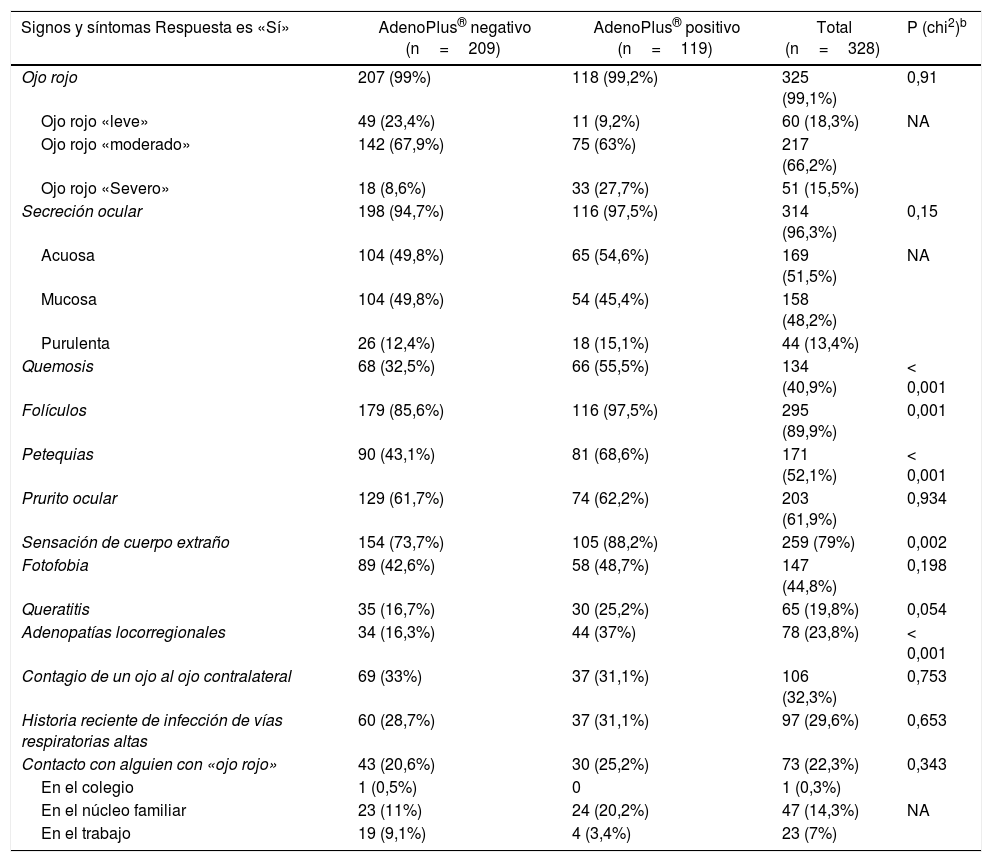Estudio epidemiológico, observacional, no intervencionista, cuya finalidad es determinar las características clínicas y la frecuencia de la conjuntivitis adenovírica diagnosticada con AdenoPlus® en pacientes que presentaban signos y síntomas de conjuntivitis aguda, así como establecer la seguridad de dicho test.
MétodoEste trabajo presenta los datos recogidos de los 386 pacientes incluidos en España. Los pacientes debían presentar signos o síntomas de conjuntivitis aguda de ≤7días de evolución. La edad mínima para participar era de 1año. Se excluyeron los pacientes ya tratados con diversos fármacos (antivíricos tópicos, esteroides tópicos o inmunomoduladores). Se utilizó un cuestionario estandarizado para recoger los datos del paciente y los resultados del test.
ResultadosVeintidós centros reclutaron 386 pacientes, de los cuales 329 fueron analizados. El porcentaje de «AdenoPlus® positivo» fue del 36,2% (119/329). En el 84,1% de casos los investigadores consideraron que la conjuntivitis era de origen vírico, pero solo el 50,3% de ellos vio su criterio clínico confirmado por el test. Los pacientes con resultado positivo a adenovirus tendían a presentar más signos y síntomas comparados con el resto de pacientes.
ConclusionesNingún signo ni síntoma puede considerarse patognomónico de la enfermedad, dificultando el diagnóstico por parte del clínico. El test AdenoPlus® es una prueba de inmunoanálisis rápida para la detección de adenovirus directamente de secreción lagrimal, y puede ser una herramienta útil para ayudar en el diagnóstico diferencial precoz en pacientes con signos y síntomas de conjuntivitis con una evolución de 7días o menos.
Non-interventional, observational, epidemiology study to assess clinical characteristics and frequency of adenovirus conjunctivitis diagnosed by AdenoPlus® in patients who presented with signs and symptoms of acute conjunctivitis. Safety aspects during use of the test were analyzed as well.
MethodThis analysis presents the data obtained from the 386 patients enrolled in Spain. Patients had to present with acute signs and symptoms of conjunctivitis ≤7days. The minimum age was 1year old. Patients who had already used local antiviral therapies, topical steroids or immuno-modulators were not allowed to enter the study. A standardized questionnaire was used to collect patient's ocular history and test results.
ResultsA total of 386 patients were recruited in 22 sites, being analyzed 329 patients. Among them, the percentage of “AdenoPlus® positive” was 36,2% (119/329). Before the test was performed, in 84,1% of the cases, investigators believed that the conjunctivitis was of viral origin but only 50,3% of the investigators had their clinical assessment confirmed by the test. Patients who tested positive for adenoviral conjunctivitis presented higher percentages of signs and symptoms than the rest of the patients.
ConclusionsNone of the signs or symptoms could be qualified as pathognomonic of the disease, being difficult for the clinicians to perform an accurate diagnosis. AdenoPlus® test is an antigen based immunoassay test that detects the presence of adenovirus directly from tears, and it can be an useful tool to help early differential diagnosis in patients with conjunctivitis signs and symptoms lasting for less than or equal to 7days.
Artículo
Comprando el artículo el PDF del mismo podrá ser descargado
Precio 19,34 €
Comprar ahora










